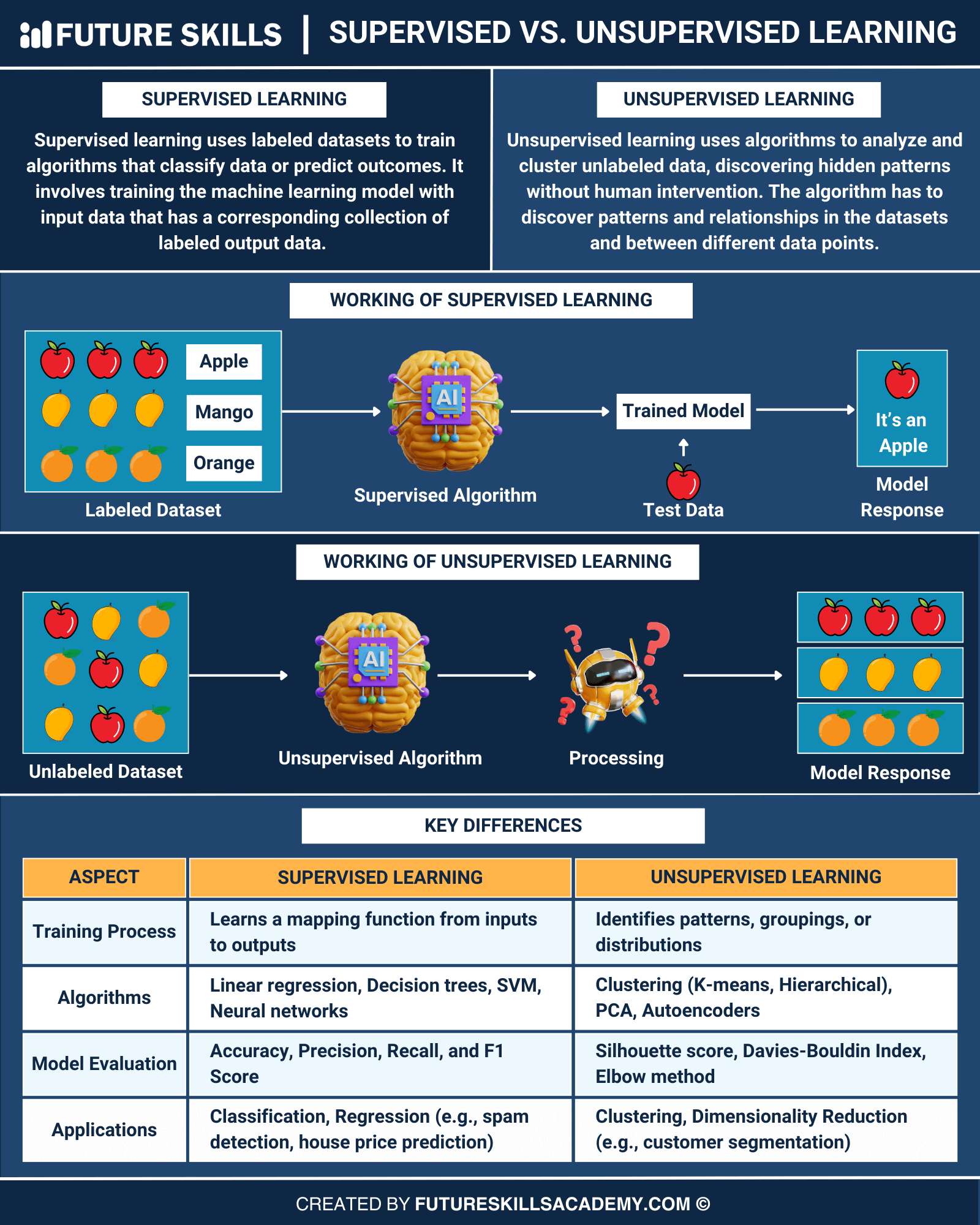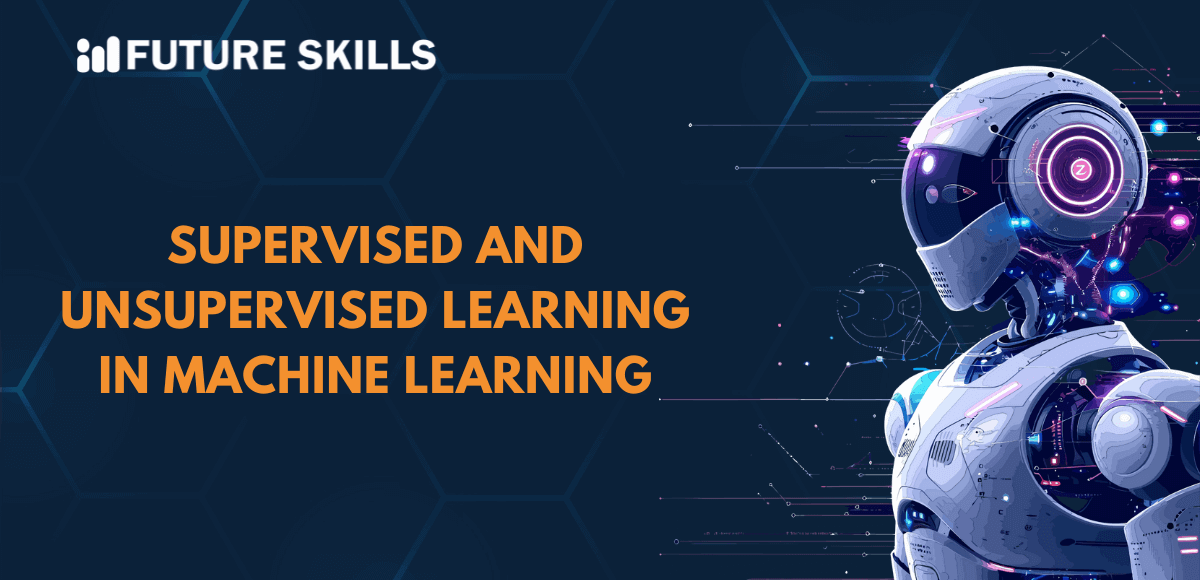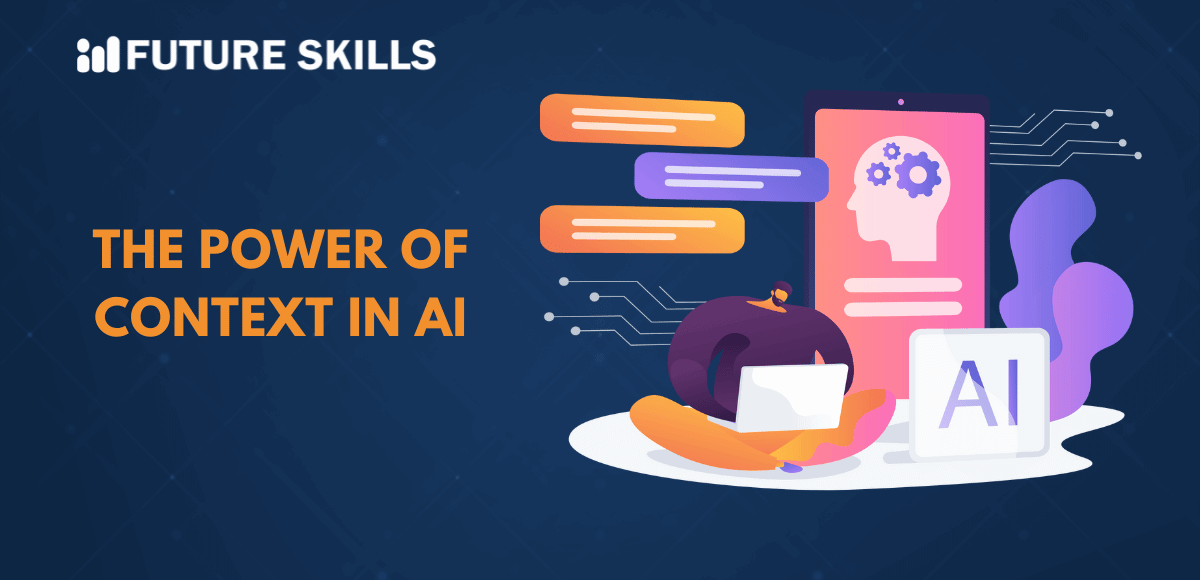Artificial intelligence has been making the world smarter across various domains. Companies want to stay updated with the latest trends and know how to adapt to changing consumer expectations as artificial intelligence makes a profound impact across different areas. The most powerful resource that can help you make the most of AI technology is machine learning. You can use supervised and unsupervised learning in machine learning according to your goals and resources at your disposal.
Supervised and unsupervised learning are the basic approaches in machine learning that differ in terms of the data used by them. You would also discover other key differences between them in which one performs better than the other. The ability to understand the differences between supervised and unsupervised learning can help you take the ideal pick in a specific situation. Let us learn more about supervised and unsupervised learning to understand the differences between them.
Learn to harness the full potential of AI with our accredited Certified AI Professional (CAIP)™ Course and pursue a career in the most demanding skill today.
Understanding the Basics of Supervised Learning
The first entry in the debate is supervised learning, an integral approach in machine learning that focuses on using labeled datasets. Labeled datasets have been designed for training algorithms to classify data or predict accurate outcomes. The difference between supervised and unsupervised learning in machine learning depends on the use of labeled inputs and outputs. The labeled data helps in measuring accuracy and ensuring continuous learning over time.
You would have to work with two distinct methods for supervised learning, such as classification and regression. Classification problems involve using an algorithm for accurate assignment of test data in different categories. Supervised learning algorithms can also help with the classification of spam in a different folder other than the inbox. Some of the common variants of classification algorithms include linear classifiers, random forest, support vector machines and decision trees.
Regression is also another popular method in supervised learning that can power algorithms with capabilities to understand the relationship between independent and dependent variables. Regression models can help with prediction of numerical values according to different data points. The popular regression algorithms include logistic regression and linear regression.
Understanding the Definition of Unsupervised Learning
Unsupervised learning is the next important player in the supervised vs. unsupervised learning debate in machine learning. You need answers to queries like ‘What is supervised and unsupervised learning in machine learning?’ for a better understanding of the differences between them. Unsupervised learning involves the use of algorithms for comprehensive analysis and clustering of unlabeled datasets. The algorithms help in discovering hidden patterns without human intervention, thereby validating the ‘unsupervised’ tag.
You can come across three prominent tasks with unsupervised learning models such as clustering, dimensionality reduction and association. Clustering focuses on grouping unlabeled data according to their differences or similarities. Association is also an important unsupervised learning technique that relies on different rules for discovering relationships between variables in a specific dataset. Dimensionality reduction is another useful technique that helps you when you have an extremely high number of features or dimensions in a dataset.
Achieve high expertise in creating prompts and become an AI expert with our leading Prompt Engineering Certification Course crafted for every enthusiastic individual.
Discovering the Techniques Used in Supervised and Unsupervised Learning
Machine learning involves teaching a computer how to draw predictions from specific datasets. The first thing you need for supervised vs. unsupervised learning in machine learning after the definition is the review of techniques. Machine learning requires using algorithms and example data for training a model, followed by integrating the model into an application for generating predictions. Let us learn about the distinct techniques used in supervised and unsupervised learning.

Supervised Learning Techniques
As you know, supervised learning in machine learning relies on labeled data. It involves training the machine learning model with input data that has a corresponding collection of labeled output data. The labeling of data is a manual procedure in most of the cases. You would have to use the following techniques for all types of supervised machine learning processes in machine learning.
-
Linear Regression
Linear regression is an important supervised learning model that helps in predicting values from a continuous scale. One of the examples of linear regression is house price prediction models that can predict the price of a house on the basis of different factors.
-
Logistic Regression
The review of supervised and unsupervised learning examples also points at logistic regression. It involves prediction of a categorical output on the basis of one or multiple inputs. The best example of logistic regression is prediction of a student’s success or failure in a unit, based on the number of classes they have attended.
-
Neural Network
Neural network techniques are more useful for supervised learning in complex use cases. It involves taking inputs and performing mathematical transformations across one or multiple layers with modification of data weights. Examples of neural network techniques in supervised learning include prediction of digits from handwritten text or images.
-
Decision Tree
Decision tree is a useful technique for supervised learning in machine learning as it involves the use of ‘if-else’ structure. The best example of a decision tree points at an application to predict customer churn. It may predict that a customer would leave when they don’t visit the application after signing up. On the other hand, it may also indicate retention when the customer accesses an application on different devices.
Unsupervised Learning Techniques
You must also learn about the techniques in unsupervised learning that can help you use it to your advantage. Unsupervised learning does not involve the use of labeled output data. The algorithm has to discover patterns and relationships in the datasets and between different data points. The following techniques can help you implement unsupervised learning in machine learning.
-
Clustering
The common explanations for supervised and unsupervised learning in machine learning must have drawn your attention towards clustering in ML. Clustering focuses on grouping specific data inputs in one category. The clustering algorithm depends on the input data and you can come across the best example in models that know different types of network traffic for predicting potential security risks.
-
Dimensionality Reduction
Dimensionality reduction is also a common approach to unsupervised learning that works by reducing the number of features in a specific dataset. It is used for pre-processing data before using them in other machine learning functions. The primary goal of dimensionality reduction focuses on reducing overheads and complexity of data for ML models.
-
Association Rule Learning
Association rule learning is another common technique used for unsupervised learning in machine learning. It focuses on unraveling rule-based relationships between different inputs in a dataset. One of the best examples of association rule learning technique is the Apriori algorithm that is capable of market basket analysis.
-
Probability Density
The journey of uncovering the difference between supervised and unsupervised learning in machine learning would also lead you to techniques like probability density. It helps in predicting the possibility of an output falling within a specific range. You can notice an example of probability density in a temperature gauge for a server room that records only within a specific range. In the event of measuring a lower number on the basis of probability distribution, the model would notify about equipment malfunction.
Discovering the Other Key Differences between Supervised and Unsupervised Learning
You can notice that the use of labeled data is one of the notable differences between supervised and unsupervised learning. The utility of supervised and unsupervised learning depends on the quality of data and the techniques they use to offer machine learning advantages. It is also important to remember that you can compare supervised learning with unsupervised learning on the basis of different factors.
The best way to find out supervised vs. unsupervised learning in machine learning is to compare their goals. Supervised learning focuses on predicting outcomes for new data with awareness of the type of results expected from ML models. On the contrary, unsupervised learning focuses on obtaining insights from large collections of new data.
The common applications of supervised learning models include sentiment analysis, price predictions, spam detection, and weather forecasting. Unsupervised learning applications include recommendation engines, medical imaging, anomaly detection, and creation of customer personas.
The level of complexity is also an important factor in the comparison between supervised and unsupervised learning as unsupervised learning requires a computationally complex model. Supervised learning is simpler as compared to unsupervised learning and involves simple programs in Python or R.
Learn about the vector databases for Machine Learning and their significance in managing complex data.
How Will You Find the Right Pick?
The best way to find the ideal approach for machine learning from supervised and unsupervised learning involves different factors. You must account for factors such as the type of input data and your goals to pick the right learning approach. It is also important to review the options you have among the algorithms with special attention to dimensionality and support for data structure and volume.
Final Thoughts
The comparison between supervised and unsupervised learning in machine learning reveals that you need both approaches for excellence in AI. You need supervised learning when you have labeled data and know the type of output you want from the model. Unsupervised learning can help in situations where you have a huge collection of unlabeled data and need new insights. Learn more about supervised and unsupervised learning to capitalize on their advantages with expert insights right away.







